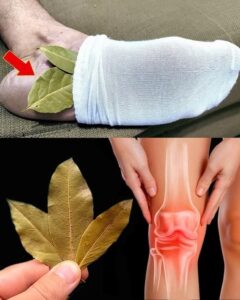You’ve probably used bay leaves to add depth to a stew, but have you ever considered tucking one into your sock?
This ancient folk remedy is gaining traction online, promising relief from pain and inflammation.
Let’s explore the claims and the science behind them.

The Claim: How It’s Supposed to Work
Proponents of the method suggest that placing a dry bay leaf inside your sock (positioned near the heel) overnight allows the body to absorb its beneficial compounds through the skin. This is said to provide targeted relief for:
-
Foot and joint pain
-
General inflammation
-
Arthritis discomfort
The Science Behind the Herb: Are There Real Benefits?
Bay leaves ( Laurus nobilis) are indeed packed with potent compounds, the most notable being eugenol.
-
Eugenol: This is the primary active ingredient, known for its anti-inflammatory and analgesic (pain-relieving) properties. It’s commonly found in over-the-counter muscle rubs and dental analgesics.
-
Other Compounds: Bay leaves also contain linalool and cineole, which have additional anti-inflammatory and soothing effects.
The Important Caveat:
While these compounds are effective when extracted, concentrated, and applied topically (e.g., in essential oils), the method of simply placing a whole, dry leaf in a sock is highly debated. The skin on the soles of the feet is thick, and it’s uncertain if enough of these compounds can be absorbed in this way to have a significant medicinal effect.
How to Try the Bay Leaf Sock Method
If you’re curious to test this natural remedy, here’s how:
-
Select a Leaf: Use a clean, dry, whole bay leaf (culinary grade is fine).
-
Position It: Place one or two leaves inside your sock, so they rest against the sole of your foot, preferably near the heel.
-
Wear Overnight: Put on the socks and wear them while you sleep.
-
Be Consistent: For best results, advocates recommend repeating this nightly for at least one to two weeks.
 Important Safety Notes
Important Safety Notes
-
Crushing the leaves is not recommended, as this can release skin-irritating compounds and sharp fragments.
-
Do not use bay leaf essential oil directly on your skin without diluting it with a carrier oil, as it can cause severe irritation.
-
This remedy is not a substitute for professional medical advice. If you have chronic pain, diabetes, or poor circulation, consult a doctor first.
So, Does It Actually Work?
The verdict is mixed.
-
The Placebo Effect is Powerful: The ritual itself—taking time for self-care—can be relaxing and may contribute to a perceived reduction in pain.
-
Aromatherapy Benefits: The subtle scent of the bay leaf may have a calming effect, which could promote better sleep and relaxation.
-
Lack of Scientific Evidence: There are no clinical studies specifically proving that a bay leaf in a sock effectively relieves pain through transdermal absorption.
-
Conclusion: It’s a harmless, low-cost experiment. You may find it offers soothing relief, but manage your expectations. The most proven benefits of bay leaves come from consuming them in teas or using their extracted oils in properly formulated products.
Proven Ways to Use Bay Leaves for Health
For more reliable benefits, try these methods:
-
Bay Leaf Tea: Steep 1-2 leaves in hot water for 10 minutes. Drinking it may aid digestion, reduce inflammation from within, and help regulate blood sugar.
-
Aromatic Steam: Add a few leaves to a bowl of hot water, lean over it with a towel over your head, and inhale. This can help clear sinus congestion.
-





